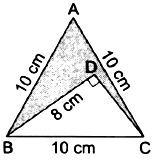In the given figure, ΔABC is an equilateral triangle the length of whose side is equal to 10 cm, and ΔDBC is right-angled at D and BD = 8 cm. Find the area of the shaded region. [Take: √3 = 1.732.].

Given: AB = BC = AC = a (let) = 10 cm
BD = 8 cm
Now,
Area of an equilateral triangle (∆ABC) = ![]()
= ![]()
= 25√3 cm2
= 43.3 cm2
Now, in ∆DBC
Base2 + Perpendicular2 = Hypotenuse2
⇒ DC2 + DB2 = BC2
⇒ DC2 = BC2-BD2
⇒ DC2 = 102-82
⇒ DC2 = 100-64
⇒ DC2 = 36 cm2
⇒ DC = 6 cm
Now,
Area of a triangle (∆DBC) = 1/2 × Base × Height
= 1/2 × DC × BC
= 1/2 × 6 cm × 8 cm
= 1/2 × 48 cm2
= 24 cm2
Now,
Area of shaded region = ∆ABC - ∆DBC
= 43.3 cm2 – 24 cm2
= 19.3 cm2
20